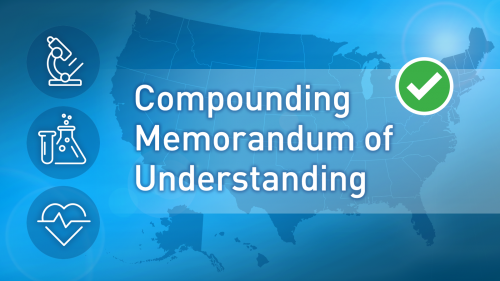FDA Announces Latest Step Toward Finalizing Memorandum of Understanding with States Addressing Compounded Drug Distribution, While Preserving Access

By: Janet Woodcock, M.D., Director, Center for Drug Evaluation and Research
Compounded drugs can serve an important role for patients whose medical needs cannot be met by an FDA-approved drug product, but they can also pose unique risks. They are not approved by the FDA and, therefore, have not been evaluated for safety, effectiveness, or quality prior to marketing. The FDA’s compounding program is a priority for the agency and aims to develop policies that ensure appropriate access to lawfully-marketed compounded drugs for patients who have a medical need for them, while also protecting public health. Over the past several years, one of the most crucial aspects of our work in this area has been to identify opportunities to partner with the states to address these important public health goals.
Today, a standard memorandum of understanding (MOU) between the FDA and the states has been made available for public viewing as part of the regulatory process, marking a significant milestone in the agency’s regulation of human drug compounding and reflecting years of collaborative dialogue and stakeholder input. The FDA has developed the MOU in close consultation with the National Association of Boards of Pharmacy (NABP), as described in the Federal Food, Drug, and Cosmetic Act (FD&C Act).
States play a vital role in reducing the risks associated with compounded drugs, while ensuring appropriate patient access. For example, if a compounder distributes drugs to multiple states, it can be difficult to gather information about possible adverse events associated with those drugs, connect them to the compounder, and undertake coordinated action to address a potentially serious public health problem. These challenges were illustrated by the 2012 nationwide fungal meningitis outbreak. This tragic outbreak led to more than 750 cases of illness and the deaths of 64 individuals. The company responsible for the outbreak had produced a compounded drug for injection that was supposed to be sterile but had become contaminated with fungus before distribution to patients and providers. This case illustrates the need for close collaboration among states, and between states and the federal government to help prevent such serious and widespread outbreaks by aiding to better identify adverse drug events and product quality concerns across the country.
Following that public health tragedy, the Drug Quality and Security Act amended section 503A of the FD&C Act to remove provisions that were held unconstitutional and the FDA was able to proceed with implementing section 503A, including developing the standard MOU, which the agency had originally drafted in 1999 following enactment of section 503A. The MOU is a key public health protection in the law and addresses certain interstate distributions of compounded drugs by traditional compounders. When finalized, the MOU will fulfill this statutory requirement and clarify areas of collaboration with the states – typically in partnership with the State Boards of Pharmacy – so that, by working together, we can have the greatest public health impact while maximizing our resources. In it, we aim to provide flexibility for states, address patient access concerns previously raised by stakeholders, while retaining critical safety provisions to help protect Americans from harm.
A key issue we have addressed in the development of the standard MOU is how to define the statutory term “inordinate amounts,” which refers to compounded drugs that are distributed interstate. In defining this term, the FDA engaged with states, pharmacy associations, pharmacies and others, about how best to balance patient risk with preserving access for patients with a medical need for a compounded drug. In the MOU, the FDA is maintaining the risk-based oversight model from the 2018 revised draft MOU – states that sign the document agree to identify pharmacy compounders that distribute inordinate amounts (greater than 50 percent) of compounded drug products interstate, as well as to report certain information to the FDA about those compounders. Pharmacy distribution of inordinate amounts of compounded drugs is a threshold for information sharing by a state and would not impose a limit on the amount of compounded drugs that a compounder could distribute interstate.
We also provided clarity in the MOU on state investigations of complaints associated with compounded drugs that have been distributed out of state. States that enter into the MOU will investigate complaints about drugs compounded at a pharmacy within their state and distributed outside of the state and advise the FDA when they receive reports of serious adverse drug experiences or serious product quality issues, like drug contamination.
One area of concern raised by stakeholders throughout this process was that additional resources may be needed by some states to collect the information requested. To address this potential resourcing issue, the FDA has entered into an agreement with NABP to make an information sharing network available to the states. Through this network, states will be able to obtain information from pharmacies in their states that report information directly into the information sharing network and transmit that information to the FDA.
Another area of interest has been the limit on prescription orders distributed out of state by a pharmacist, pharmacy or physician in states that do not sign the MOU. The law (section 503A of the FD&C Act) limits distribution of compounded drugs outside the state by a pharmacist, pharmacy, or physician located in a state that has not entered into the MOU to 5 percent of its total prescription orders dispensed or distributed.
The final MOU and the statutory 5 percent limit do not apply to drugs compounded by outsourcing facilities under section 503B of the FD&C Act and they do not apply to drugs that are compounded for animals.
As part of the Paperwork Reduction Act approval process for government public information collection, the MOU is being made available today for viewing. Pending clearance by the U.S. Office of Management and Budget, states will be briefed and will have the opportunity to review and sign the MOU. To provide ample time for state review, we intend to increase the amount of time after the final MOU is made available for signature, from 180 days to 365 days before the FDA intends to enforce the five percent limit in states that have not signed the final MOU. This extended timeframe should correspond to a full legislative cycle for most states, giving sufficient time for states to modify their laws and regulations, if necessary.
We anticipate the final MOU, once signed, will help to facilitate increased collaboration between the FDA and the states that sign it. Working together, we can help promote quality compounding practices and better address emerging public health concerns that may affect patients.
We’ve made important progress over the past few years on implementing more effective compounding policies as well as training, collaboration, and stakeholder engagement. The FDA remains committed to a drug compounding program that closely aligns with our mission to protect consumers and promote opportunities to improve health.

